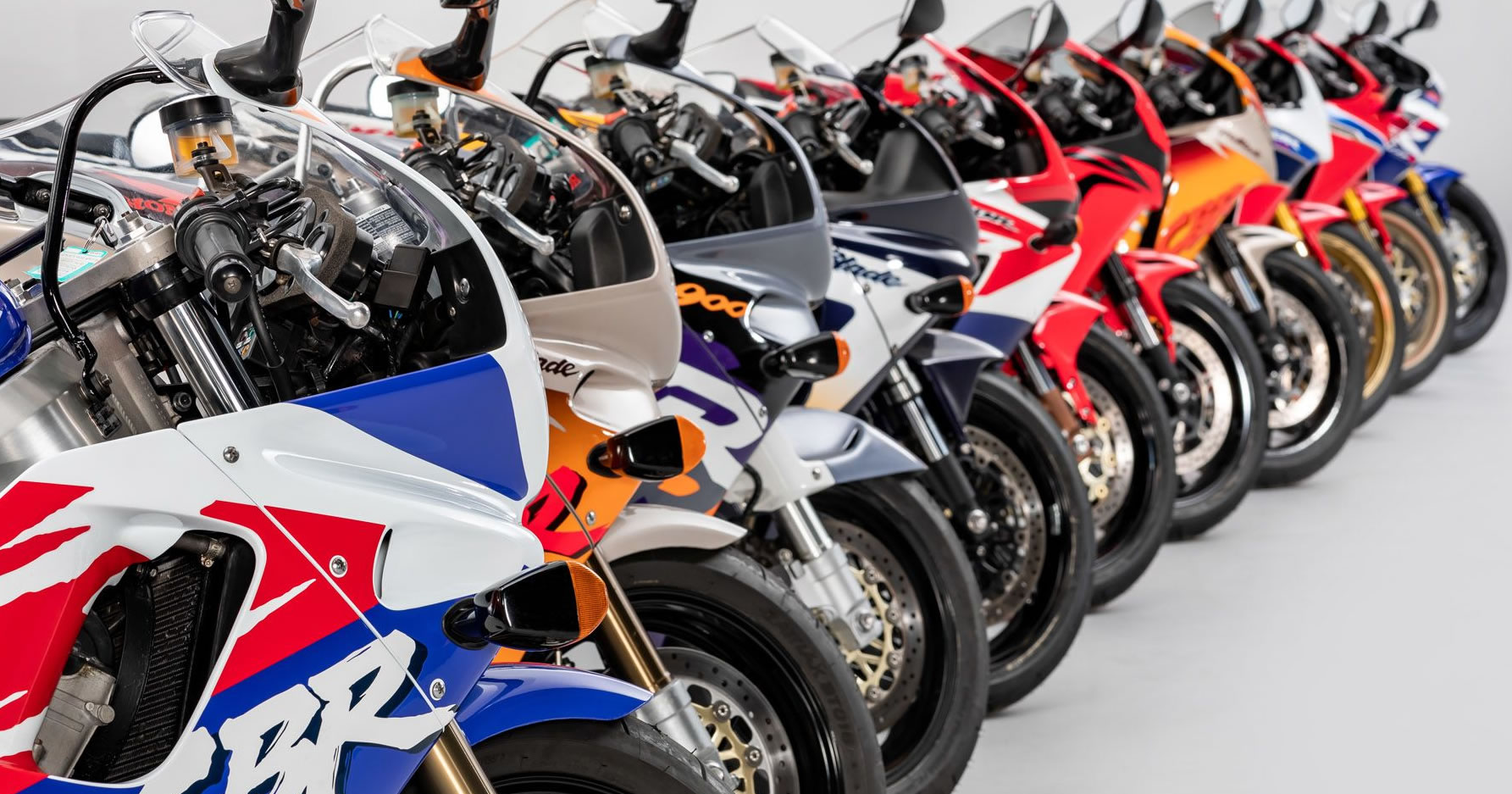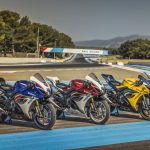

The Complete History of the Honda Fireblade (1992–2025)
The Honda Fireblade isn’t just a motorcycle—it’s a revolution that reshaped the superbike landscape. Launched in 1992, the Fireblade (or “Blade”) introduced a radical shift in how high-performance motorcycles were built: prioritising agility, weight reduction, and rider confidence over sheer horsepower alone. Through more than three decades of evolution, the Fireblade has remained a symbol of cutting-edge engineering, race-winning performance, and innovation.
Birth of a Revolution – The Fireblade Concept (Late 1980s–1992)
In the late 1980s, Honda engineer Tadao Baba had a vision: create a bike that combined 1000cc-class power with the size and agility of a 600cc machine. The dominant litre bikes of the time were fast but heavy—Baba-san believed there was another way.
The Development Philosophy
- “Total Control” became the design mantra.
- The original prototype was based on the CBR750, sleeved up to 893cc.
- Extensive testing on tracks like Phillip Island showed a lighter bike could outperform more powerful rivals in real-world conditions.

The Groundbreaker – CBR900RR (SC28, 1992–1995)
In 1992, the Honda CBR900RR was launched. It immediately stunned the motorcycling world with its:
- 893cc inline-four engine
- Dry weight of 185kg
- 122 bhp
- Short wheelbase and aggressive geometry
Compared to its competitors, the CBR900RR felt nimble and responsive—changing direction like a 600 but with brutal power.
1994–1995 Updates: The “Foxeye” CBR
- New fairing with distinctive dual “foxeye” headlights
- Updated front forks and lighter wheels
- Refinement of chassis rigidity for better feedback
The Evolution – CBR919RR (SC33, 1996–1999)
For 1996, Honda increased the engine capacity to 918cc, bumped power to 128 bhp, and refined the chassis. The SC33 featured:
- New digital ignition system
- Lighter frame with improved flex characteristics
- Enhanced cooling and smoother throttle response
By the late 1990s, the Fireblade was cemented as the king of real-world superbikes.
A Modern Blade – CBR929RR & CBR954RR (2000–2003)
CBR929RR (2000–2001)
- First fuel-injected Fireblade
- Lightweight titanium exhaust
- New aluminium frame and Unit Pro-Link rear suspension
- 149 bhp, 195 kg wet weight
CBR954RR (2002–2003)
- Displacement bumped to 954cc
- Output increased to 155 bhp
- More track-focused ergonomics
These were the final Fireblades influenced directly by Tadao Baba, who retired after their success.

The Liter-Class Shift – CBR1000RR (SC57, 2004–2007)
In 2004, Honda introduced the CBR1000RR:
- All-new design inspired by the RC211V MotoGP bike
- 998cc engine, 172 bhp, HESD steering damper
- New Unit Pro-Link suspension, centralised mass
Though heavier than some rivals, it offered supreme balance, rideability, and track-day credentials.
2006 Update
- Sharper styling
- Minor weight reduction
- Revised mapping and exhaust
Performance Refinement – SC59 (2008–2011)
This version featured:
- Lighter, more compact chassis
- 999cc engine producing 178 bhp
- Slipper clutch added
- Improved midrange torque
In 2009, the Fireblade became more electronics-oriented. While it lacked some of the gadgets of competitors, its natural chassis balance and feedback kept it loved.
Fireblade Goes Premium – SC77 (2017–2019)
Big Leap in Electronics
- Selectable torque control, wheelie control, cornering ABS
- Quickshifter, TFT display, multiple riding modes
- Introduction of SP and SP2 variants
- SP: Öhlins semi-active suspension, lightweight battery
- SP2: race homologation special with titanium valves
Despite high-tech upgrades, it still remained smaller and lighter than many rivals.
Fireblade Reimagined – CBR1000RR‑R (2020–2024)
Honda overhauled the Blade in 2020:
- CBR1000RR-R Fireblade and Fireblade SP
- 999.9cc inline‑four engine, revving to 14,500 rpm
- Peak power: 214 bhp, more than Ducati Panigale V4
- Winglets for aerodynamics
- Full suite of rider aids with six-axis IMU
- SP model included Brembo Stylema brakes and Öhlins suspension
This generation focused squarely on track supremacy. While less docile for street riders, it won over hardcore enthusiasts and racers.
30 Years of the Blade – The Anniversary Edition
In 2022, Honda celebrated 30 years of Fireblade with a special edition:
- Classic 1992 tri-color livery
- Gold highlights, numbered plaques
- Track-honed upgrades
Collectors and fans saw this as a tribute to both history and future legacy.
Fireblade in Racing – From TT to WSBK
Though the Fireblade hasn’t always dominated World Superbike, it’s made history in:
- Isle of Man TT – John McGuinness’s iconic wins
- British Superbike Championship
- Endurance World Championship
It also nurtured loyal privateers who trusted its reliability and balance.

The Fireblade Legacy (2025 and Beyond)
As of 2025, the Fireblade continues to evolve:
- Rumors of a hybrid or lightweight electric variant are growing
- Honda is refining its aerodynamics, IMU calibration, and emissions compliance
- The Fireblade remains a top contender for riders seeking true connection to the road and track
From its revolutionary 1992 debut to today’s 214 bhp track weapons, the Fireblade has constantly evolved without losing its soul. It embodies the spirit of innovation and control, shaped by engineers, racers, and passionate riders across generations.
Whether you’re looking back at a classic SC28 or aiming for the next SP variant, the Honda Fireblade stands as one of the most iconic superbikes ever built.
Add a comment Cancel reply
Comments (0)
Categories
- Bike Reviews (14)
- General Motorcycling (30)
- Rider Training & Advice (5)
- Roads & Rides (6)
- Why it Matters (4)
Recent Posts
About us

Popular Tags
Related posts


The Pocket Super Duke: Why the 2017 KTM 390 Duke Rewrote the A2 Rulebook

Hollywood's Hell Cycles - The Most Iconic and Menacing Movie Motorcycles for Halloween

Sell Your Bike the Easy Way: Why Mallory Motorcycles Beats eBay Private Sales
Nationwide Motorcycle Delivery
No corner of the UK is too far for the delivery team and it’s partners at Mallory Motorcycles. We proudly deliver to all major cities, towns, and even remote areas across the entire nation, including:
- London, England
- Birmingham, England
- Leeds, England
- Manchester, England
- Sheffield, England
- Milton Keynes, England
- Salford, England
- Sunderland, England
- Brighton & Hove, England
- Portsmouth, England
- York, England
- Colchester, England
- Chelmsford, England
- Exeter, England
- Gloucester, England
- Winchester, England
- Bradford, England
- Oxford, England
- Ripon, England
- Wells, England
- Liverpool, England
- Bristol, England
- Leicester, England
- Coventry, England
- Wakefield, England
- Nottingham, England
- Newcastle upon Tyne, England
- Doncaster, England
- Wolverhampton, England
- Kingston upon Hull, England
- Plymouth, England
- Derby, England
- Stoke-on-Trent, England
- Southampton, England
- Peterborough, England
- Southend-on-Sea, England
- Canterbury, England
- Preston, England
- Cambridge, England
- St. Albans, England
- Lancaster, England
- Norwich, England
- Chester, England
- Wrexham, England
- Durham, England
- Carlisle, England
- Worcester, England
- Lincoln, England
- Bath, England
- Hereford, England
- Salisbury, England
- Lichfield, England
- Chichester, England
- Newry, England
- Truro, England
- Ely, England
- Belfast, Northern Ireland
- Londonderry, Northern Ireland
- Lisburn, Northern Ireland
- Armagh, Northern Ireland
- Glasgow, Scotland
- Edinburgh, Scotland
- Aberdeen, Scotland
- Dundee, Scotland
- Dunfermline, Scotland
- Inverness, Scotland
- Stirling, Scotland
- Perth, Scotland
- Cardiff, Wales
- Swansea, Wales
- Newport, Wales
- Bangor, Wales
- St. Asaph, Wales
- St. Davids, Wales

Mallory Motorcycles Ltd is registered in England and Wales (Company Registration number 13948787). Registered Address Unit 2 Griffon Road, Derbyshire DE7 4RF. Authorised and Regulated by the Financial Conduct Authority (number 1037062). Mallory Motorcycles Ltd is a credit broker and not a lender. We can introduce you to a limited number of finance lenders and for such introductions we will receive commission. The commission payment can be either a fixed fee or a fixed percentage of the amount you borrow. The lenders we work with could pay commission at different rates. The commission we receive will not affect the amount you repay under the credit agreement. All finance is subject to status. Terms and conditions apply. Applicants must be 18 years or over.







